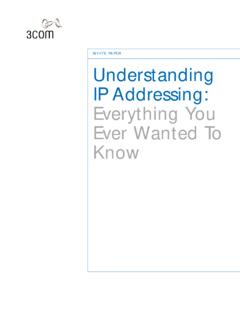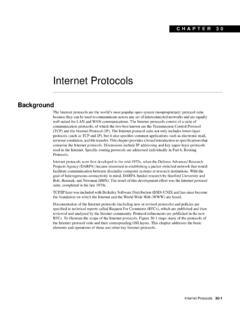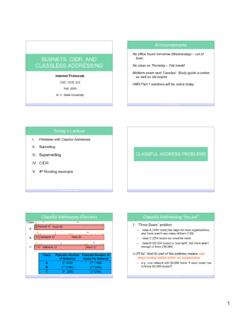Transcription of Classless Subnetting Explained - Keystone College
1 1 Classless Subnetting Explained Rick Graziani, Cabrillo College When given an IP Address, Base Network Mask, and a Subnet Mask, how can you determine other information such as: The subnet address of this subnet The broadcast address of this subnet The range of Host Addresses for this subnet The maximum number of subnets for this subnet mask The number of hosts for each subnet The number of subnet bits The number of this subnet Let s start with an example: Host IP Address Network Mask (/16)Major (Base) Network Address Major Network Broadcast Address Total Number of Host Bits Number of Hosts Subnet Mask (/26)Number of Subnet Bits Number of Usable Subnets (zero subnet used) Number of Host Bits per Subnet Number of Usable Hosts per Subnet Subnet Address for this IP Address IP Address of First Host on this Subnet IP Address of Last Host on this Subnet Broadcast Address for this Subnet Part 1: Determine Major Network Information Before we begin Subnetting , let s gather some information regarding the network in general.
2 Using the Major Network Mask, determine the major network Address, the broadcast address for the entire network, and the number of hosts for the entire network. IP Address Major Network Mask Step 1: Translate Host IP Address and Major Network Mask into binary notation Convert the Host IP Address and Major Network Mask to binary: Address 10001010 01100101 01110010 11111010 Base Mask 11111111 11111111 00000000 00000000 2: Major Network Address 1. Draw a line under the base mask 2. Perform a bit-wise AND operation on the IP Address and the Subnet Mask Note: 1 AND 1 results in a 1, 0 AND anything results in a 0 3. Express the result in Dotted Decimal Notation 4. The result is the Major Network Address of this for this host IP Address is Address 10001010 01100101 01110010 11111010 Base Mask 11111111111111110000000000000000 Network Add. 10001010 01100101 00000000 00000000 13810100 Step 3: Broadcast Address for the Major Network Address Remember that the network mask separates the network portion of the address from the host portion.
3 The network address has all 0 s in the host portion of the address while the broadcast address has all 1 s in the host portion of the address. 213810100 Network Add. 10001010 01100101 00000000 00000000 Base Mask 11111111 11111111 00000000 00000000 Broadcast. 10001010 01100101 11111111 11111111 138101255255 Network portionHost portionBy counting the number of host bits we can determine the total number of usable hosts for this network (before Subnetting ). Host bits: 16 Total number of hosts: 216 = 4,096 4,096 2 = 4,094 (Can t use the all 0 s address, network address, or the all 1 s address, broadcast address.) Add this information to our table: Host IP Address Network Mask (/16)Major (Base) Network Address Major Network Broadcast Address Total Number of Host Bits Number of Hosts 16 bits or 216 or 4,096 total hosts 4,096 2 = 4,094 usable hosts Subnet Mask (/26)Number of Subnet Bits Number of Usable Subnets (zero subnet used) Number of Host Bits per Subnet Number of Usable Hosts per Subnet Subnet Address for this IP Address IP Address of First Host on this Subnet IP Address of Last Host on this Subnet Broadcast Address for this Subnet Part 2: Determine Subnet Information Step 1: Translate Host IP Address and Subnet Mask into binary notation Address 10001010 01100101 01110010 11111010 Subnet Mask 11111111 11111111 11111111 11000000 2: Determine the Network (or Subnet) where this Host address lives: 1.
4 Draw a line under the mask 2. Perform a bit-wise AND operation on the IP Address and the Subnet Mask Note: 1 AND 1 results in a 1, 0 AND anything results in a 0 3. Express the result in Dotted Decimal Notation 4. The result is the Subnet Address of this Subnet which is Address 10001010 01100101 01110010 11111010 Subnet Mask 11111111111111111111111111000000 Subnet Add. 10001010 01100101 01110010 11000000 138101114192 Add this information to our table: Subnet Address for this IP Address Step 3: Determine which bits in the address contain Network information and which contain Host information:1. Draw the Great Divide ( ) as a wavy line where the 1 s in the Base Network Mask ends (also the mask if there was no Subnetting ). In our example, the Base Network Mask is or the first 16 left-most bits. 2. Draw the Small Divide ( ) as a straight line where the 1 s in the given Subnet Mask ends. Thenetwork information ends where the 1 s in the mask IP Address 10001010 01100101 01110010 11 111010 Subnet Mask 11111111111111111111111111 000000 Subnet Add.
5 10001010 01100101 01110010 11 000000 10 bits3. The result is the Number of Subnet Bits may be determined by simply counting the number of bits between the and , which in this case is 10 4: Determine bit ranges that are for subnets and for hosts: 1. Label the subnet counting range between the and the (these are the bits that are being incremented to make the subnet numbers or addresses). 2. Label the host counting range between the and all of the way to the end on the right (these are the bits that are being incremented to make the host numbers or addresses). IP Address 10001010 01100101 01110010 11 111010 Subnet Mask 11111111111111111111111111 000000 Subnet Add. 10001010 01100101 01110010 11 000000 subnet host counting range counting range 4 Step 5: Determine the range of host addresses available on this subnet, and the broadcast address on this subnet: 1.
6 Copy down all of the network/subnet bits of the Network Address( all bits before the ) 2. In the host portion (to the right of the ) make the host bits all 0 s except for the right most bit (or least significant bit), which you make a 1. This gives you the first Host IP Address on this subnet, which is the first part of the result for Range of Host Addresses for This Subnet, or in our Now, in the host portion (to the right of the ) make the host bits all 1 s except for the right most bit (or least significant bit), which you make a 0. This gives you the last Host IP Address on this subnet, which is the last part of the result for Range of Host Addresses for This Subnet, or in our In the host portion (to the right of the ) make the host bits all 1 s. This gives you the Broadcast IP Address on this subnet. This is the result for Broadcast Address of This Subnet, or in our IP Address 10001010 01100101 01110010 11 111010 Subnet Mask 11111111111111111111111111 000000 Subnet Add.
7 10001010 01100101 01110010 11 000000 subnet host counting range counting range First Host 10001010 01100101 01110010 11 000001 138101114 193 Last Host 10001010 01100101 01110010 11 111110 138101114 254 Broadcast 10001010 01100101 01110010 11 111111 1381011142555 Let s add some of this information to our table: Host IP Address Network Mask (/16)Major (Base) Network Address Major Network Broadcast Address Total Number of Host Bits Number of Hosts 16 bits or 216 or 4,096 total hosts 4,096 2 = 4,094 usable hosts Subnet Mask (/26)Number of Subnet Bits Number of Usable Subnets (zero subnet used) Number of Host Bits per Subnet Number of Usable Hosts per Subnet Subnet Address for this IP Address IP Address of First Host on this Subnet IP Address of Last Host on this Subnet Broadcast Address for this Subnet Step 6: Determine the number of usable subnets The number of subnets is determined by how many bits are in the subnet counting range (in this example, 10 bits) minus 1 for the last subnet, the all ones subnet which is not usually used.
8 The first subnet, known as the all zeroes subnet is normally a usable subnet. 1. Use the formula 2n 1, where n is the number of bit in the subnet counting 210 1 = 1024 1 = 1023 3. Subtract 1 from the number of usable subnets (the all zeroes subnet) Number of Subnet Bits Number of Usable Subnets (zero subnet used) 10 bits 210 1 = 1024 1 = 1023 usable subnets Step 7: Determine the number usable hosts per subnet The number of hosts per subnet is determined by the number of host bits (in this example, 6 bits) minus 2 (1 for the subnet address and 1 for the broadcast address of the subnet). 26 2 = 64 -2 = 62 hosts per subnet Number of Host Bits per Subnet Number of Usable Hosts per Subnet 6 bits 26 2 = 64 -2 = 62 hosts per subnet 6 Final Answers Host IP Address Network Mask (/16)Major (Base) Network Address Major Network Broadcast Address Total Number of Host Bits Number of Hosts 16 bits or 216 or 4,096 total hosts 4,096 2 = 4,094 usable hosts Subnet Mask (/26)Number of Subnet Bits Number of Usable Subnets (zero subnet used) 10 bits 210 1 = 1024 1 = 1023 usable subnets Number of Host Bits per Subnet Number of Usable Hosts per Subnet 6 bits 26 2 = 64 -2 = 62 hosts per subnet Subnet Address for this IP Address IP Address of First Host on this Subnet IP Address of Last Host on this Subnet Broadcast Address for this Subnet Other Stuff Borrowing Bits How many bits to you need to borrow to create a certain number of subnets or a certain number of hosts per subnet?
9 Using this chart, you can easily determine the number of bits you need to borrow. Remember to: o Subtract 1 for the usable number of subnets, the all 1 s subnet. This is assuming the all 0 s subnet is a usable subnet. o Subtract 2 for the usable number of hosts per subnet, one for the subnet address and one for the broadcast address of the subnet. 210292827262524232221201,024 5122561286432168421 Number of bits borrowed: 109876543211,024 5122561286432168421 Hosts or Subnets Possible Subnet Mask Values Because subnet masks must be contiguous 1 s followed by contiguous 0 s, the converted dotted decimal notation can contain one of a certain number of values: 25411111110 25211111100 24811111000 24011110000 22411100000 19211000000 12810000000 000000000









